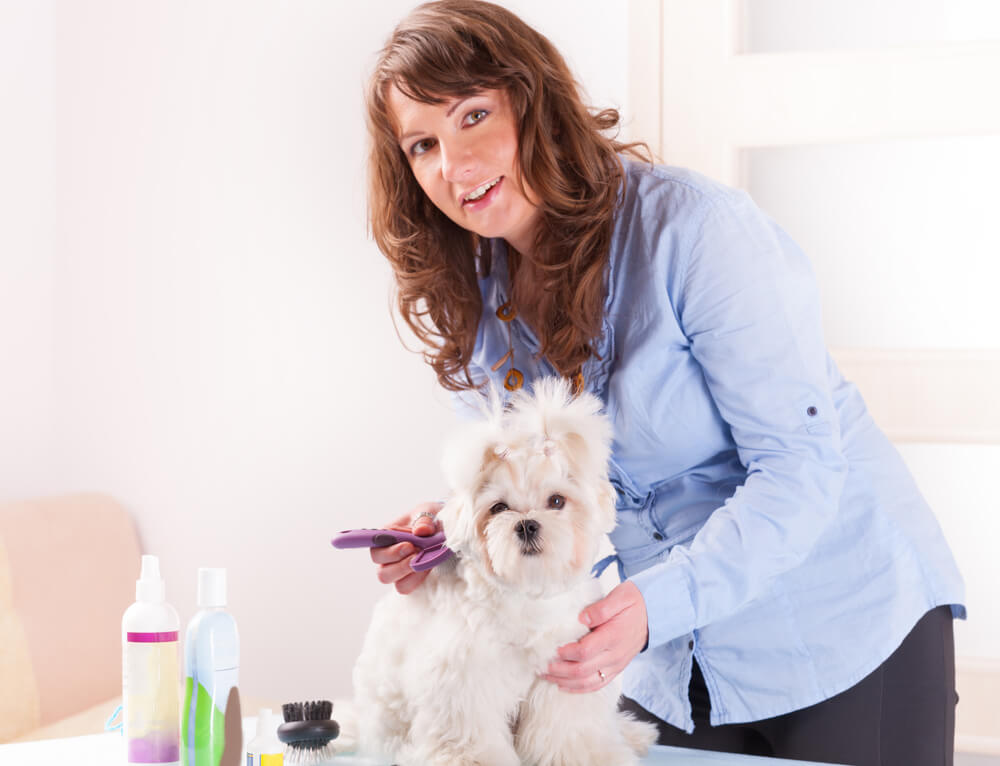Dog grooming is not much different from how we groom ourselves. The only major difference is that they cannot do it themselves and have to rely on their handlers to do it for them. We can opt to groom our dogs ourselves or we can take them to a grooming salon, like Groom – Dog Care With Love, who does professional dog grooming in West Hollywood, CA, if we are not up to the task. Whichever way, grooming keeps our dogs healthy and makes them feel vibrant.
Grooming a dog by yourself creates that bonding time between you and your canine and saves you a lot of money, your dog will however not resent you for taking him/her to a groomer. The type of grooming approach you adopt depends on the dog breed and the type of hair. Here are grooming basics to keep your dog extra sparkly.
Removing mats and tangles
Before any grooming takes place, the dog has to be made comfortable by petting. The groomer then takes this opportunity to locate areas with tangled or matted hair. Using a detangling solution, he/she removes the mats and tangles, before they come into contact with water. Matted hair is hard to remove when it is wet. A special tool known as a matting rake may be used on dogs with a lot of matted hair.
Hair trimming
This is done to dogs with continuously growing hair. On average, dog hair is cut after every 2-4 weeks. Most long-haired breeds require haircuts around the belly, chest, feet pads and hocks. Unless you are a trained groomer, hair trimming should be left to professionals.
Hair brushing/combing
Hair brushing is very important to dogs as it keeps their coats healthy. Hair brushing also strengthens the bond between the dog and his groomer, because dogs generally enjoy the brushing sessions. The frequency of brushing depends on the breed of the dog. Long-haired dogs need to be brushed daily to prevent tangling and matting of their hairs.
Medium-haired dogs require haircuts at least once a week, although their hair is also prone to tangling and matting.
Short-haired dogs have the least problems with matting and tangling and can go several weeks without brushing. Poor hair brushing practices can result in hair build-up, which can be a serious problem during the shedding season. Hair is basically brushed from front to back and then, from top to bottom. Starting with the head, the entire coat of hair is combed including the tail.
This procedure is constant for all dogs. The difference is the type of tools used in brushing different coat hairs. For instance, FURminator de-shedding tools are used for brushing short-haired coats, while slicker brushes are used for long-haired coats.
Bathing
Bathing is a tricky issue when it comes to dogs. While others enjoy it, most dogs resent bathing with a passion. Whether the dogs like it or not, bathing is really crucial for their hygiene and wellbeing. Bathing is among the few grooming methods that do not require the services of groomers.
The most important thing to note is to use shampoo intended for dogs. Many people make the mistake of using human shampoos, which irritate the dogs’ skin.
Washing the dog outside is also recommended as it is less messy. The water should neither be too hot nor too cold. In case you wash the dog in the bathtub, ensure that you place non-slip rags to prevent the dog from slipping.
To keep water out of the dog’s ears, you can use cotton balls. Using bare hands, lather the dog’s skin with shampoo. Rubbing and massaging should be done from head to tail and from top to bottom. Using bare hands creates better lather and gives a good feel for the dog’s body. You can locate sores and injuries better using bare hands.
Care must be adhered to in order to keep shampoo from the dog’s eyes. Once the whole body is fully lathered (excluding eyes), rinse the dog thoroughly with lukewarm water. The dog’s coat can then be dried using a dry towel followed by a blow dryer. The blow dryer should be on no heat setting.
Caring for the ears
Ears should also be kept clean like all other parts of a dog’s body. Neglecting ears may result in bacteria and yeast build-up, and the dog may end up with serious ear problems. Signs of poorly maintained ears include bad odor and debris.
Dog ears can be easily cleaned using ear solutions to remove the excess wax and debris from ear flaps and external canal. Do not clean too deep as this may damage the eardrums.
Trimming toenails
Toenails are clipped when they overgrow to the point that they click on the floor whenever the dog walks. Long unkempt nails can be avenues for serious infections. Nail clipping is however not fun for all dogs and your dog may act aggressive when you approach him/her with clipping tools. Trimming should therefore be left to professionals. If you feel that you are up to the task, then ensure there is someone present to hold the dog as you clip his/her nails. You should ensure that the dog is comfortable before you start clipping.
Brushing teeth
Just like human teeth, dog teeth require regular maintenance too. Accumulation of food remains and dirt makes dog teeth to decay. Dog teeth are cleaned with a toothbrush and toothpaste paste made specifically for dogs. Human toothpaste should be avoided at all cost.

